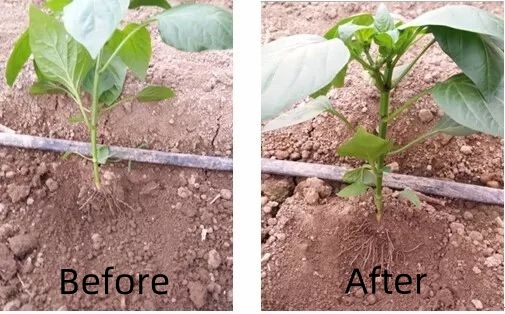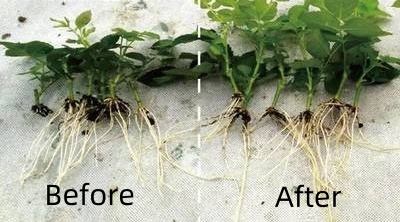IBA Indole-3-butyric acid 98%TC
Introduction
Potassium indolebutyrate, chemical formula C12H12KNO2, pink powder or yellow crystal, soluble in water, mostly used as a plant growth regulator for cell division and cell proliferation, to promote grass and woody plant root meristem.
| Used for Object | Potassium indolebutyrate mainly acts on cucumbers, tomatoes, eggplants, and peppers. Rooting of cuttings of trees and flowers, apples, peaches, pears, citrus, grapes, kiwi, strawberry, poinsettia, dianthus, chrysanthemum, rose, magnolia, tea tree, poplar, rhododendron, etc. |
| Usage and dosage | 1. Potassium indolebutyrate dipping method: Dip the base of the cuttings with 50-300ppm for 6-24 hours depending on the difficulty of rooting. 2. Potassium indolebutyrate quick soaking method: Depending on the difficulty of rooting of the cuttings, use 500-1000ppm to soak the base of the cuttings for 5-8 seconds. 3. Potassium indolebutyrate dipped in powder method: Mix potassium indolebutyrate with talc powder and other additives, soak the base of the cuttings, dip them in powder, and cut. Fertilize with 3-6 grams per mu, drip irrigation with 1.0-1.5 grams, and seed dressing with 0.05 grams of original medicine and 30 kilograms of seeds. |
| Features | 1. After potassium indolebutyrate is converted into potassium salt, it is more stable than indolebutyric acid and completely water-soluble. 2. Potassium indolebutyrate can break seed dormancy and strengthen roots. 3. The most commonly used raw material for cutting and transplanting of large and small trees. 4. The best regulator for rooting and strengthening seedlings when the temperature is low in winter. Scope of application of potassium indolebutyrate: It is mainly used as a rooting agent for cuttings, and can also be used as a synergist for flushing, drip irrigation, and foliar fertilizers. |
| Advantage | 1. Potassium indolebutyrate can act on all vigorously growing parts of the plant, such as roots, buds, and fruits. It will strongly show cell division in the specifically treated parts and promote growth. 2. Potassium indolebutyrate has the characteristics of long-term effect and specificity. 3. Potassium indolebutyrate can promote the growth of new roots, induce the formation of root bodies, and promote the formation of adventitious roots in cuttings. 4. Potassium indolebutyrate has good stability and is safe to use. It is a good rooting and growth promoter. |
|
Feature
|
Potassium indolebutyrate is a root-promoting plant growth regulator. It induces the formation of adventitious roots in crops. Through leaf spraying, root dipping, etc., it is transmitted from leaves, seeds and other parts to the plant body, and is concentrated at the growing point, promoting cell division and inducing the formation of adventitious roots, which are characterized by multiple, straight, and long roots. Thick, with many root hairs. It is easily soluble in water, has higher activity than indole acetic acid, will slowly decompose under strong light, and has a stable molecular structure when stored under light-shielding conditions. |
Application method and dosage
K-IBA promote root growth well for many crops in single use,It have a better effect and wide-spectrum after mix with other PGR.Suggested application dosage as below:
(1)Wash fertilizer:2-3g/667square meters.
(2)Irrigation fertilizer:1-2g/667square meters.
(3)Basic fertilizer:2-3g/667square meters.
(4)Seed dressing:0.5g K-IBA(98%TC)with 30kg seed.
(5)Seed soaking(12h-24h):50-100ppm
(6) Quick dip(3s-5s):500ppm-1000ppm
K-IBA+Sodium NAA:When used to promote root growth,usually mix with Sodium NAA as the ratio of 1:5,not only enhance root growth well,but also decrease cost.
Action and mechanism
1. Potassium indolebutyrate can act on the vigorous growth parts of the whole body of the plant, such as roots, buds, fruits, and strongly shows cell division and promotes growth in the specially treated parts.
2. Potassium indolebutyrate has the characteristics of long-term and specific.
3. Potassium indolebutyrate can promote the growth of new roots, induce the formation of root body, and promote the formation of advental roots.
4. Potassium indolebutyrate stability is good, safe to use, is a good rooting growth agent.
Functional characteristics
1. After potassium indolebutyrate becomes potassium salt, its stability is stronger than that of indolebutyrate and it is completely water-soluble.
2. Potassium indolebutyrate breaks seed dormancy and can take root and strengthen roots.
3.Pig trees and small trees, the most used raw medicine products for cutting transplanting.
4.The best regulator for rooting and seedling in low temperature in winter.
Potassium indolebutyrate application scope: mainly used for cutting rooting agent, can also be used in irrigation, drip irrigation, foliar fertilizer synergist.
Usage and dosage
1.Potassium indolebutyrate impregnation method: according to the different conditions of the cuttings difficult to root, soak the base of the cuttings with 50-300ppm for 6-24 hours.
2.Potassium indolebutyrate fast leaching method: according to the different conditions of the cuttings difficult to root, use 500-1000ppm to soak the base of the cuttings for 5-8 seconds.
3.Potassium indolebutyrate dipping powder method: After mixing potassium indolebutyrate with talc powder and other additives, the cutting base is soaked, dipped in powder, and cut.
Flush and fertilize 3–6 grams of water per mu, drip irrigation 1.0-1.5 grams, mix seed 0.05 grams of raw medicine and mix 30 kilograms of seeds.
Application


Action object
Potassium indolebutyrate mainly acts on cucumbers, tomatoes, eggplants, peppers. Tree, flower cutting root, apple, peach, pear, citrus, grape, kiwi, strawberry, poinsettia, carnation, chrysanthemum, rose, magnolia, tea tree, poplar, cuckoo and so on.
First aid measure
Emergency rescue:
Inhalation: If inhaled, move the patient to fresh air.
Skin contact: Remove contaminated clothing and rinse skin thoroughly with soap and water. If you feel uncomfortable, seek medical attention.
Eye contact: Separate eyelids and rinse with running water or normal saline. Seek immediate medical attention.
Ingestion: Gargle, do not induce vomiting. Seek immediate medical attention.
Advice to protect the rescuer:
Move the patient to a safe place. Consult a doctor. Present this chemical safety technical manual to the doctor on site.










